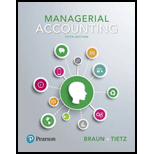
Concept explainers
Comprehensive summary problem (Learning Objectives 2 & 3)
Birdfeeders Unlimited makes backyard birdfeeders. The company sells the birdfeeders to home improvement stores for $15 per birdfeeder. Each birdfeeder requires 1.5 board feet of wood, which the company obtains at a cost of $4 per board foot. The company would like to maintain an ending stock of wood equal to 10% of the next month’s production requirements. The company would also like to maintain an ending stock of finished birdfeeders equal to 20% of the next month’s sales.
Sales data for the company is as follows:
| Units | |
| October actual sales (prior year) | 92.000 |
| November actual sales (prior year) | 85.000 |
| December actual sales (prior year) | 78.000 |
| January projected sales | 80.000 |
| February projected sales | 90.000 |
| March projected sales | 95.000 |
| April projected sales | 105,000 |
In any given month, 20% of the total sales are cash sales, while the remainder are credit sales. The company’s collection history indicates that 80% of credit sales is collected in the month after the sale, 10% is collected two months after the sale, 6% is collected three months after the sale, and the remaining 4% is never collected.
Assume that the total cost of direct materials purchases in December was $550,000. The company pays 45% of its direct materials purchases in the month of purchase and pays the remaining 55% in the month after purchase.
Requirements
Prepare the following budgets for the first three months of the year, as well as a summary budget for the quarter:
- 1. Prepare the sales budget, including a separate section that details the type of sales made (cash versus credit).
- 2. Prepare the production budget.
- 3. Prepare the direct materials purchases budget. Assume the company needs 120,000 board feet of wood for production in April.
- 4. Prepare the cash collections budget for January, February, and March, as well as a summary for the first quarter.
- 5. Prepare the
cash payments budget for direct materials purchases for the months of January, February, and March, as well as a summary for the first quarter.
Want to see the full answer?
Check out a sample textbook solution
Chapter 9 Solutions
Managerial Accounting (5th Edition)
- No AIarrow_forwardL.L. Bean operates two factories that produce its popular Bean boots (also known as "duck boots") in its home state of Maine. Since L.L. Bean prides itself on manufacturing its boots in Maine and not outsourcing, backorders for its boots can be high. In 2014, L.L. Bean sold about 450,000 pairs of the boots. At one point during 2014, it had a backorder level of about 100,000 pairs of boots. L.L. Bean can manufacture about 2,200 pairs of its duck boots each day with its factories running 24/7.In 2015, L.L. Bean expects to sell more than 500,000 pairs of its duck boots. As of late November 2015, the backorder quantity for Bean Boots was estimated to be about 50,000 pairs. Question: Assume that a pair of 8" Bean Boots are ordered on December 3, 2015. The order price is $109. The sales tax rate in the state in which the boots are order is 7%. L.L. Bean ships the boots on January 29, 2016. Assume same-day shipping for the sake of simplicity. On what day would L.L. Bean recognize the…arrow_forwardFinancial accounting questionarrow_forward
 Managerial Accounting: The Cornerstone of Busines...AccountingISBN:9781337115773Author:Maryanne M. Mowen, Don R. Hansen, Dan L. HeitgerPublisher:Cengage Learning
Managerial Accounting: The Cornerstone of Busines...AccountingISBN:9781337115773Author:Maryanne M. Mowen, Don R. Hansen, Dan L. HeitgerPublisher:Cengage Learning Cornerstones of Cost Management (Cornerstones Ser...AccountingISBN:9781305970663Author:Don R. Hansen, Maryanne M. MowenPublisher:Cengage LearningPrinciples of Accounting Volume 2AccountingISBN:9781947172609Author:OpenStaxPublisher:OpenStax College
Cornerstones of Cost Management (Cornerstones Ser...AccountingISBN:9781305970663Author:Don R. Hansen, Maryanne M. MowenPublisher:Cengage LearningPrinciples of Accounting Volume 2AccountingISBN:9781947172609Author:OpenStaxPublisher:OpenStax College Essentials Of Business AnalyticsStatisticsISBN:9781285187273Author:Camm, Jeff.Publisher:Cengage Learning,
Essentials Of Business AnalyticsStatisticsISBN:9781285187273Author:Camm, Jeff.Publisher:Cengage Learning,



